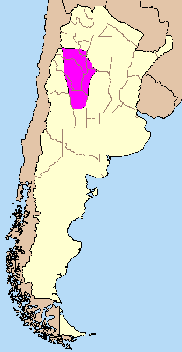|
Ischigualasto
Ischigualasto Provincial Park ( es, Parque Provincial Ischigualasto), also called ''Valle de la Luna'' ("Valley of the Moon" or "Moon Valley"), due to its moon like appearance, is a provincial protected area in the north-east of San Juan Province, north-western Argentina, limiting to the north with the Talampaya National Park, in La Rioja Province. Both areas belong to the same geological formation, the Ischigualasto Formation (sometimes called the Ischigualasto-Talampaya Formation). Established on 3 November 1971, the park has an area of . In 2000, UNESCO included Ischigualasto and Talampaya National Park among its World Heritage Sites. History The name Ischigualasto is derived from the extinct Cacán language, spoken by an indigenous group referred to as the Diaguita by the Spanish conquistadors and means "place where the moon alights". Another hypothesis gives the name "Ischigualasto" a Quechua origin, meaning "dead land", although some scholars have proposed Huarpe roots ... [...More Info...] [...Related Items...] OR: [Wikipedia] [Google] [Baidu] |
San Juan Province (Argentina)
San Juan Province () is a province of Argentina, located in the western part of the country. Neighbouring provinces are, moving clockwise from the north, La Rioja, San Luis and Mendoza. It borders with Chile to the west. The province has an area of 89,651 km2, covering a mountainous region with scarce vegetation, fertile oases and turbulent rivers. Throughout the entire province there are an important number of paleontological sites. Similar to other regions in Argentina, agriculture is one of the most important economic activities, highlighting wine production and olive oil. Additionally, a variety of fruits and vegetables are produced in the fertile valleys irrigated by artificial channels in the western part, close to the Andes mountain range. This is the second province in volume of wine production at the national level and in South America, and possesses outstanding varietal wines. It is also an important center of mining and oil production. History Before the ... [...More Info...] [...Related Items...] OR: [Wikipedia] [Google] [Baidu] |
Valle Fértil Department
Valle Fértil is a department of the province of San Juan (Argentina). Characterized by highly fertile landscapes and contains the Ischigualasto Provincial Park, also known as the ''Valley of the Moon'', which is visited by tourists from around the world. Origin of the name The Spaniards, upon their arrival, found the indigenous people referred to the area as "Chaj Nai--Paj", which means "green or fertile country of many rivers". Tourism The main attraction is Ischigualasto, a strange landscape, in what may have been one of the most interesting stages of the earth's history, the Triassic period, the place known as the Valley of the Moon, for the apparent resemblance to a lunar landscape. It is a protected area for the preservation and study of strange geological formations, wildlife, flora and fossil A fossil (from Classical Latin , ) is any preserved remains, impression, or trace of any once-living thing from a past geological age. Examples include bones, shells, e ... [...More Info...] [...Related Items...] OR: [Wikipedia] [Google] [Baidu] |
Exaeretodon
''Exaeretodon'' is an extinct genus of fairly large, low-slung traversodontid cynodonts from the southern parts of Pangea. Four species are known, from various formations. ''E. argentinus'' is from the Carnian-age (Late Triassic) Cancha de Bochas Member of the Ischigualasto Formation in the Ischigualasto-Villa Unión Basin in northwestern Argentina. ''E. major'' and ''E. riograndensis'' are from the Carnian-age portion of the Santa Maria Formation of the Paraná Basin in southeastern Brazil. ''E. statisticae'' is from the Carnian-age Lower Maleri Formation of India. Description This genus was an herbivore up to long, with a specialized grinding action when feeding. An analysis of the size of the bones of calves collected in Paleorrota concluded that the mother ''Exaeretodon'' had one or two calves, for one pregnancy. Taxonomy When he first named the species, Argentine paleontologist José Bonaparte mentioned several features that distinguish it from all other traverso ... [...More Info...] [...Related Items...] OR: [Wikipedia] [Google] [Baidu] |
Talampaya National Park
Talampaya National Park ( es, Parque Nacional Talampaya) is a national park located in the east/centre of La Rioja Province, Argentina. It was designated a provincial reserve in 1975, a national park in 1997, and a UNESCO World Heritage Site in 2000. Location The park protects an area of the High Monte ecoregion. The park covers an area of , at an altitude of above mean sea level. Its purpose is to protect important archaeological and palaeontological sites found in the area. It has landscapes of great beauty, with flora and fauna typical of the mountain biome. The park is in a basin between the Cerro Los Colorados to the west and the Sierra de Sañagasta to the east. The landscape is the result of erosion by water and wind in a desert climate, with large ranges in temperature - high heat by day and low temperature at night, with torrential rain in summer and strong wind in spring. Features The park includes: *The dry bed of the Talampaya River, where dinosaurs lived milli ... [...More Info...] [...Related Items...] OR: [Wikipedia] [Google] [Baidu] |
Badlands
Badlands are a type of dry terrain where softer sedimentary rocks and clay-rich soils have been extensively eroded."Badlands" in '' Chambers's Encyclopædia''. London: George Newnes, 1961, Vol. 2, p. 47. They are characterized by steep slopes, minimal vegetation, lack of a substantial regolith, and high drainage density.A.J. Parsons and A.D. Abrahams, Editors (2009) ''Geomorphology of Desert Environments'' (2nd ed.) Springer Science & Business Media Ravines, gullies, buttes, hoodoos and other such geologic forms are common in badlands. Badlands are found on every continent except Antarctica, being most common where there are unconsolidated sediments. They are often difficult to navigate by foot, and are unsuitable for agriculture. Most are a result of natural processes, but destruction of vegetation by overgrazing or pollution can produce anthropogenic badlands. Badlands topography Badlands are characterized by a distinctive badlands topography. This is terrain i ... [...More Info...] [...Related Items...] OR: [Wikipedia] [Google] [Baidu] |
Traversodontid
Traversodontidae is an extinct family of herbivorous cynodonts. Traversodonts were primarily Gondwanan, with many species known from Africa and South America. Recently, traversodonts have also been found from Europe and eastern North America. Traversodonts first appeared in the Middle Triassic and diversified in the Late Triassic before going extinct at the end of the epoch. The family Traversodontidae was erected by Friedrich von Huene in 1936 for cynodonts first found in São Pedro do Sul in Paleorrota, Brazil. Description Traversodonts are members of Gomphodontia, a group of herbivorous cynognathian cynodonts. As an adaptation toward eating plants, they have wide postcanine teeth behind large canines. These postcanines are closely spaced with their crowns touching each other. Each is usually wider than it is long and is covered in several cusps. Because of their complexity, postcanine teeth are the primary means of identifying and distinguishing different species of travers ... [...More Info...] [...Related Items...] OR: [Wikipedia] [Google] [Baidu] |
Zonda Wind
Zonda wind ( es, viento zonda) is a regional term for the foehn wind that often occurs on the eastern slope of the Andes, in Argentina. Formation The Zonda is a dry wind (often carrying dust) which comes from the polar maritime air, warmed by descent from the crest, which is approximately above sea level. It may exceed a velocity of . The Zonda wind is produced by the northeastward movement of polar fronts, and although is hot and dry at the low-lands, it is the main mechanism for snow precipitation at the high altitude chains, where it looks as ''viento blanco'', reaching speeds sometimes over 200 km/h. Thus, instead of being a snow-eater, this wind is particularly important for this arid region, as it is connected to the buildup of the winter snow cover and accumulation over the scarce local glaciers. Occurrence While this type of föhn wind may occur over most central parts of western Argentina, its effects are more impressive in La Rioja, San Juan, and northern Mendoza pro ... [...More Info...] [...Related Items...] OR: [Wikipedia] [Google] [Baidu] |
Cactus
A cactus (, or less commonly, cactus) is a member of the plant family Cactaceae, a family comprising about 127 genera with some 1750 known species of the order Caryophyllales. The word ''cactus'' derives, through Latin, from the Ancient Greek word (''káktos''), a name originally used by Theophrastus for a spiny plant whose identity is now not certain. Cacti occur in a wide range of shapes and sizes. Although some species live in quite humid environments, most cacti live in habitats subject to at least some drought. Many live in extremely dry environments, even being found in the Atacama Desert, one of the driest places on Earth. Because of this, cacti show many adaptations to conserve water. For example, almost all cacti are succulents, meaning they have thickened, fleshy parts adapted to store water. Unlike many other succulents, the stem is the only part of most cacti where this vital process takes place. Most species of cacti have lost true leaves, retaining only spin ... [...More Info...] [...Related Items...] OR: [Wikipedia] [Google] [Baidu] |
Central Sierras
The Sierras Pampeanas (also called Central Sierras or Pampas Sierras) (English: Pampas Mountains) is a geographical region of Argentina. The Sierras Pampeanas are a chain of mountains that rise sharply from the surrounding pampa region of Northwest Argentina. They run parallel to the Andes Mountains and their crest line is some east of the Andes crest line (running from 29° to 35° S latitude at about 65° W longitude). They cross into seven Argentina provinces: San Luis, San Juan, Córdoba, La Rioja, Catamarca, Santiago del Estero and Tucumán. Geography The highest point of the Sierras Pampeanas is Cerro General Belgrano (6250 m above sea level) in La Rioja, in the Sierra de Famatina. Between the mountain ranges are several salt-filled depressions. The Salinas Grandes depression is located in Cordoba, La Rioja, Catamarca and Santiago del Estero. A characteristic of many of these mountain ranges is their morphological asymmetry: the western slopes are usually steep ... [...More Info...] [...Related Items...] OR: [Wikipedia] [Google] [Baidu] |
Amsl
Height above mean sea level is a measure of the vertical distance (height, elevation or altitude) of a location in reference to a historic mean sea level taken as a vertical datum. In geodesy, it is formalized as '' orthometric heights''. The combination of unit of measurement and the physical quantity (height) is called "metres above mean sea level" in the metric system, while in United States customary and imperial units it would be called " feet above mean sea level". Mean sea levels are affected by climate change and other factors and change over time. For this and other reasons, recorded measurements of elevation above sea level at a reference time in history might differ from the actual elevation of a given location over sea level at a given moment. Uses Metres above sea level is the standard measurement of the elevation or altitude of: * Geographic locations such as towns, mountains and other landmarks. * The top of buildings and other structures. * Flying objects s ... [...More Info...] [...Related Items...] OR: [Wikipedia] [Google] [Baidu] |






